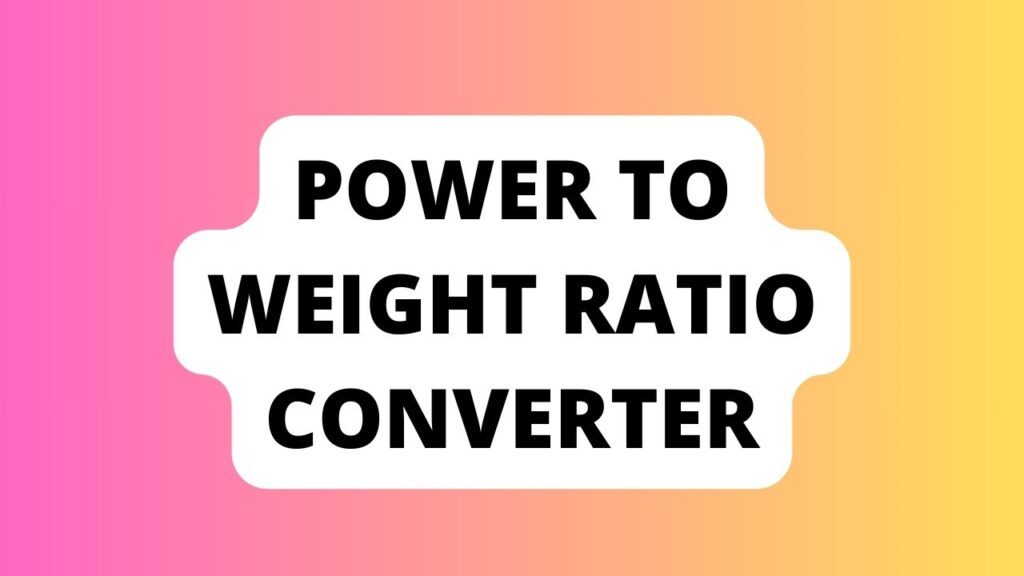Introduction
What is Power to Weight Ratio?
Power to Weight Ratio Converter When discussing vehicle performance, the power to weight ratio emerges as a critical metric. Simply put, it evaluates the relationship between an engine’s power output and the vehicle’s weight. A higher power to weight ratio signifies a better performance potential, influencing speed, agility, and fuel efficiency.
Importance of Power to Weight Ratio
Advantages of a High Power to Weight Ratio
Vehicles or athletes boasting a high power to weight ratio revel in enhanced performance. In the automotive world, this translates to quicker acceleration, better handling, and improved fuel efficiency. Athletes, too, experience swifter movements and agility when their power to weight ratio is optimized.
Consequences of a Low Power to Weight Ratio
Conversely, a lower ratio entails reduced efficiency, sluggishness, and compromised performance. Heavier vehicles struggle with acceleration and responsiveness, while athletes face limitations in speed and endurance.
Understanding Power to Weight Ratio
Definition and Calculation
The power to weight ratio is calculated by dividing the power output (in horsepower or watts) by the weight of the object (in pounds or kilograms). Simply put, it determines how much power is available for every unit of mass.
Understanding Power to Weight Ratio
Calculating Power to Weight Ratio
To calculate this ratio, divide the vehicle’s power output by its total weight. It’s a simple yet pivotal equation that aids in understanding how efficiently a vehicle converts power into motion.
Factors Affecting Power to Weight Ratio
Several factors contribute to this ratio, including engine capacity, vehicle weight, and additional load. Understanding these elements allows drivers and engineers to optimize performance.
Significance in Performance
Role in Vehicle Speed
The power to weight ratio directly impacts a vehicle’s speed. A higher ratio often results in quicker acceleration and enhanced top speeds, crucial in racing and everyday driving alike.
Impact on Fuel Efficiency
Efficiency-minded drivers value this ratio as it correlates with fuel efficiency. A well-balanced ratio translates to better mileage, reducing the vehicle’s environmental footprint.

Power to Weight Ratio Converter
Types of Converters Available
Various tools assist in calculating this ratio, from online calculators to specialized devices. Understanding these options ensures accurate performance evaluations.
How to Use a Power to Weight Ratio Converter
Utilizing these converters involves inputting specific data, such as horsepower and vehicle weight, to attain a precise ratio figure.
Applications
Motorsport Industry
In the motorsport industry, this ratio is pivotal. Teams analyze and optimize it to gain a competitive edge, tweaking vehicle components to achieve an ideal balance.
Everyday Vehicle Maintenance
For everyday drivers, understanding and optimizing this ratio can enhance vehicle handling, improve acceleration, and prolong engine life.
Benefits
Enhanced Vehicle Performance
An ideal power to weight ratio enhances vehicle responsiveness and overall performance, delivering a dynamic driving experience.
Improved Handling and Acceleration
Balancing this ratio optimizes a vehicle’s handling, making maneuvers more responsive and precise.
FAQs
How does Power to Weight Ratio Impact Electric Vehicles?
Electric vehicles benefit significantly from a favorable power to weight ratio, contributing to their efficiency and range.
Can You Modify the Power to Weight Ratio of a Vehicle?
Yes, modifying vehicle components like engines or reducing weight can alter this ratio, impacting performance.
What’s an Ideal Power to Weight Ratio for Racing Cars?
Racing cars often aim for a high ratio, ensuring swift acceleration and top speeds, typically ranging between 6 to 8 pounds per horsepower.
How Does Altitude Affect Power to Weight Ratio?
Higher altitudes can impact engine performance due to reduced air density, affecting the ratio’s calculation.
Are Electric Vehicles Better in Terms of Power to Weight Ratio?
Electric vehicles often boast impressive ratios due to their efficient electric motors and lighter weight from battery advancements.
How Does Aerodynamics Influence Power to Weight Ratio?
Aerodynamics play a crucial role, affecting a vehicle’s drag coefficient and consequently altering its power to weight ratio.
Conclusion
Summary of Key Points
Understanding and optimizing the power to weight ratio significantly impacts a vehicle’s performance, from speed to fuel efficiency. This metric, crucial in both racing and everyday driving, remains a cornerstone of vehicle engineering and driver experience.
